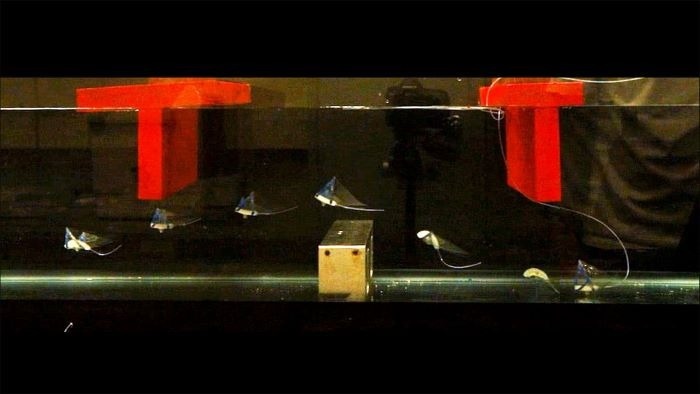Reviewed by Lexie CornerDec 5 2024
An international group of researchers from North Carolina State University took inspiration from manta rays to improve their control over a robot's motion in the water, surpassing the record for the fastest swimming soft robot. The study was published in the journal Science Advances.

Image credit: Haitao Qing, North Carolina State University
Two years ago, we demonstrated an aquatic soft robot that was able to reach average speeds of 3.74 body lengths per second. We have improved on that design. Our new soft robot is more energy efficient and reaches a speed of 6.8 body lengths per second. In addition, the previous model could only swim on the surface of the water. Our new robot is capable of swimming up and down throughout the water column.
Jie Yin, Study Corresponding Author and Associate Professor, North Carolina State University
The soft robot is made from a material that remains stable when the fins are spread wide, resembling the fins of a manta ray. The fins are attached to a flexible silicone body that contains a chamber capable of being filled with air.
When the air chamber is inflated, the fins bend in a motion similar to the downstroke of a manta ray's flapping fins. Once the air is released from the chamber, the fins naturally return to their original position.
Pumping air into the chamber introduces energy into the system. The fins want to return to their stable state, so releasing the air also releases the energy in the fins. That means we only need one actuator for the robot and allows for more rapid actuation.
Haitao Qing, Study First Author, and Ph.D. Student, North Carolina State University
Controlling the soft robot's vertical movement also required a thorough understanding of manta ray fluid dynamics.
We observed the swimming motion of manta rays and were able to mimic that behavior to control whether the robot swims toward the surface, swims downward, or maintains its position in the water column. When manta rays swim, they produce two jets of water that move them forward. Mantas alter their trajectory by altering their swimming motion. We adopted a similar technique for controlling the vertical movement of this swimming robot. We are still working on techniques that will give us fine control over lateral movements.
Jiacheng Guo, Study Co-Author and Ph.D. Student, University of Virginia
Yuanhang Zhu, Study Co-Author and Assistant Professor of Mechanical Engineering at the University of California, Riverside, said, “Specifically, simulations and experiments showed us that the downward jet produced by our robot is more powerful than its upward jet. If the robot flaps its fins quickly, it will rise upward. But if we slow down the actuation frequency, this allows the robot to sink slightly in between flapping its fins – allowing it to either dive downward or swim at the same depth.”
Qing said, “Another factor that comes into play is that we are powering this robot with compressed air. That is relevant because when the robot’s fins are at rest, the air chamber is empty, reducing the robot’s buoyancy. And when the robot is flapping its fins slowly, the fins are at rest more often. In other words, the faster the robot flaps its fins, the more time the air chamber is full, making it more buoyant.”
The researchers demonstrated the soft robot's functionality in two key ways. First, the robot's initial version successfully navigated a set of obstacles placed on both the floor and surface of a water tank. Second, they showed that the untethered robot could carry a payload, including its own air and power source, while moving across the water's surface.
Yin said, “This is a highly engineered design, but the fundamental concepts are fairly simple. And with only a single actuation input, our robot can navigate a complex vertical environment. We are now working on improving lateral movement and exploring other modes of actuation, which will significantly enhance this system’s capabilities. Our goal is to do this with a design that retains that elegant simplicity.”
Additional authors include Yinding Chi and Yaoye Hong, former Ph.D. students at NC State, as well as Daniel Quinn and Haibo Dong from UVA.
The research was supported by the National Science Foundation and the Office of Naval Research.
Manta ray-inspired fast and maneuverable soft swimming robots
Video Credit: North Carolina State University
Journal Reference:
Qing, H., et al. (2024) Spontaneous snapping-induced jet flows for fast, maneuverable surface and underwater soft flapping swimmer. Science Advances. doi.org/10.1126/sciadv.adq4222.